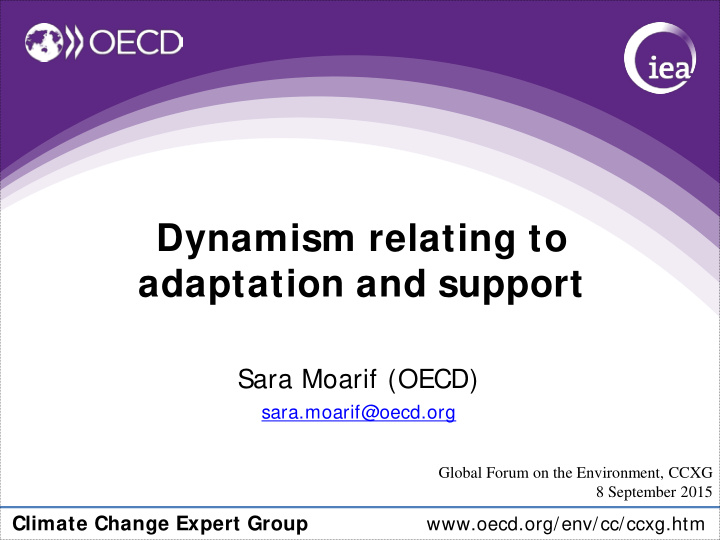



Dynamism relating to adaptation and support Sara Moarif (OECD) sara.moarif@oecd.org Global Forum on the Environment, CCXG 8 September 2015 Climate Change Expert Group www.oecd.org/env/cc/ccxg.htm
Presentation outline Background and context General elements included when discussing dynamism for mitigation actions How these elements could apply to o Adaptation o Means of implementation Concluding remarks Discussion questions Climate Change Expert Group 2
Context 2015 agreement to strengthen and encourage best efforts in all areas of climate action, including adaptation and means of implementation Mitigation, adaptation, means of implementation connected to each other… …though connections are neither immediate (in time) nor linear, are country-specific and influenced by nat’l actions Recognition that processes to ensure dynamism in each of the three areas will take different forms o Dynamism: process that allows actions taken under the 2015 agreement to respond to changing needs, circumstances and knowledge Climate Change Expert Group 3
Natural disasters Scientific Economic Source: NASA Goddard Factors leading to Source: Wikimedia Commons changes in climate Source: Wikimedia Commons Political Technological action Demographic Source: Wikimedia Commons Source: Solar Impulse Source: Greg Briner Climate Change Expert Group 4
Elements for dynamism in mitigation reporting and verification systems Collective or Collective Transparency / Measurement, global multilateral objective process Individual, National country-level “contribution” at multilateral regular intervals process Progression over time Climate Change Expert Group 5
Could these categories apply to adaptation? Collective • Qualitative, focused on reducing vulnerabilities, managing risk, and enhancing resilience and adaptive capacity objective • Captured in current INDCs and “undertakings” National • Could have common timeline for communication action • Diverse set of measures • Take stock of progress and trends at national level; Collective difficult to aggregate /global process • Sharing knowledge and lessons between countries • Assess outcomes of actions taken, indicators Individual, • Progress with implementation; success, challenges, needs country • Assessing changes in risks, vulnerabilities process • NAP Process • Continuously addressing changes in risks, vulnerabilities, Progression priorities over time • Greater coverage (geographic, economic) of adaptation planning Climate Change Expert Group 6
Could these categories apply to means of implementation? • Not clear Collective • Mitigation and adaptation objectives: require expansion objective and shift investments and financial flows • Provision and/or mobilisation: Not clear National • Commitment to “greening” domestic flows action • Amount of finance required indentified in some INDCs Collective • Assessment of climate finance and support flows, e.g. SCF /global • Quadrennial replenishment cycles, strengthened reviews process Individual, • Potentially through strengthened transparency and MRV country systems process • Increased scale Effectiveness (improved outcomes) Progression • Better integration of CC across spending, econ activity over time • Overall “greening” Improved country alignment • Improved mobilisation Climate Change Expert Group 7
Concluding remarks Adaptation planning and implementation a dynamic process at the national level (often 5-7 years) o Identification of risks and needs evolves, regular assessments lead to changes in adaptation planning Climate support flows are also dynamic, in practice responding to various factors (national level 1-2 years; multiannual replenishments) o Progress can be determined in many ways o Arguably, impact “on the ground” most important (ability to act; gradual transformation toward low-emission, climate resilient economic systems) Links between mitigation, adaptation and support will emerge within all processes o Some Parties have proposed overarching, integrated global stocktake > would also draw out links Climate Change Expert Group 8
Discussion questions Could the notion of continuously enhancing mitigation ambition be applied to adaptation, and if so, how? What framework is needed to deliver climate support over time in the context of evolving needs and capabilities? Climate Change Expert Group 9
Recommend
More recommend